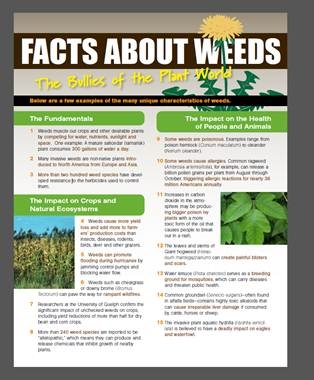The Weed Science Society of America (WSSA) Public Awareness Committee with contributions from WSSA members, released a new fact sheet on weeds.
The press release text is pasted the text below (in black) or you can click HERE for the direct link. Click here for a link to the pdf.
Brad
WSSA OFFERS NEW FACT SHEET ON WEEDS, THE BULLIES OF THE PLANT WORLD
Did you know that the invention of Velcro® was inspired by prickly weed burs that stuck to the pants of a Swiss engineer during a walk with his dog? It's one of the many unique facts about weeds captured in a free brochure available from the Weed Science Society of America.
Created by the organization's Public Awareness Committee with contributions from WSSA members, the document illustrates a few of the many unique characteristics of weeds and how they touch our lives. Examples include:
- The Fundamentals.Weeds muscle out crops and other desirable plants by competing for water, nutrients, sunlight and space. One example: A mature saltcedar [tamarisk] plant consumes 300 gallons of water a day.
- The Impact on Crops and Natural Ecosystems.Weeds can promote flooding during hurricanes by jamming control pumps and blocking water flow.
- The Impact on the Health of People and Animals. Some weeds are poisonous. Examples range from poison hemlock (Conium maculatum) to oleander (Nerium oleander).
- Weeds on the Move. Tiny seeds from horseweed (Conyza canadensis) have been known to travel 300 miles by air. Specially equipped model airplanes have tracked horseweed seed in the earth's planetary boundary layer.
- Weeds Growing by Leaps and Bounds. A single four-inch shoot hydrilla (Hydrilla verticillata) can grow by 3,200 inches in just 35 days.
- Weeds Reproducing for Long-Term Survival.Each acre of U.S. cropland contains 50 million to 300 million buried weed seeds. Five to 10 percent of them germinate and emerge each year.
- Weeds That are Edible. Small nutlets found at the tips of underground stems of yellow nutsedge (Cyperus esculentus) are edible and taste like almonds.
- Odd Facts about Weeds. Cows that graze on garlic mustard (Alliaria petiolata) or other mustard weeds produce milk with a garlic flavor. Similarly, wild garlic (Allium vineale) can "flavor" wheat crops and reduce their market value. It’s NOT the best way to make garlic bread!
The new brochure is available for download from the WSSA website: http://wssa.net/WSSA/Articles/WSSA-Facts-About-Weeds.pdf